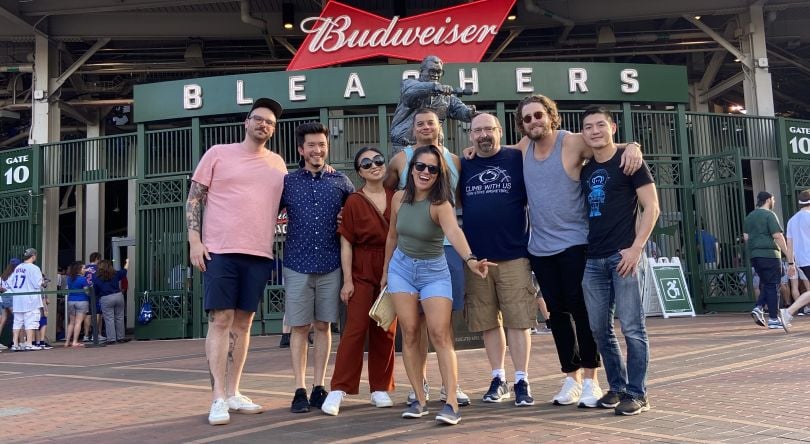Behind Lob’s success is a culture deeply rooted in transparency, communication and collaboration.
Community is the backbone, from the company’s weekly all-hands meeting to quarterly town hall sessions to its focus on facilitating cross-department synergy. Openness is rewarded, diverse perspectives are sought out and knowledge is intended to be shared — not stifled.
“Given that many of our initiatives span multiple teams, it is essential to maintain an open line of communication,” said Print Delivery Network Operations Specialist Kate Sanders. “Lob leaders actively ensure that projects are prioritized and allocated based on the collective bandwidth.”
As Lob has scaled, trust and connectedness have empowered its team to work together to achieve shared goals quickly.
“One of Lob’s core values is ‘move fast, take action,’ and usually this means we aren’t going to have ten meetings before we kick off, or maybe there isn’t time to reach out to every single stakeholder each day,” explained Senior Product Marketing Manager Walker Palecek.
“Instead, if we’ve aligned our goals at the start of an initiative, we have faith in each other to execute.”
Another Lob team member, Director of P&M Analytics Terry Wu, noted that it all comes back to the individuals that make up each team.
“I find it important to build strong personal relationships so as to foster a foundation for collaboration, communication and alignment,” said Wu.
These professionals dove into the different pieces that comprise Lob’s approach to effective cross-functional collaboration.

Diverse Perspectives
A department’s initiatives don’t exist in a vacuum. Conversely, each team lends its distinct viewpoints and skills to advance company goals. For Sanders, these intersecting roles have become a source of inspiration and improvement.
“I’ve actively sought to understand and appreciate the work of colleagues from different departments,” explained Sanders. “While our overarching objectives remain consistent, I’ve discovered that each team employs unique strategies and metrics to gauge progress.”
“While our overarching objectives remain consistent, I’ve discovered that each team employs unique strategies and metrics to gauge progress.”
Recently, close collaboration with the sales team challenged Sanders to communicate how aspects of operations could benefit potential customers and how the two departments align with each other’s needs.
“Through this experience, I’ve gained a deeper understanding of the customer-centric approach and how our operations contribute to our sales efforts,” said Sanders. “By understanding how colleagues in various departments think and operate, I’ve uncovered ways my team can offer support and vice versa.”
These interactions serve as catalysts for future shared successes and strengthened bonds. As Sanders noted, “Collaboration not only enriches our collective capabilities but also fosters a sense of unity across our organization.”

In The Loop
As Lob has scaled, the company has prioritized cross-functional collaboration and adopted new systems to ensure communication remains solid and proactive.
At the heart of this strategy is open dialogue.
“Lob has navigated challenges of cross-functional collaboration and alignment by working hard to keep communication channels open and keep teams informed,” said Wu while discussing weekly working group sessions.
During these meetings, all teams report on key initiatives and metrics, said Wu: “In these meetings, teams are free to openly speak up on key blockers and share successes for all other teams to be looped in.”
In Wu’s role, he works closely with many cross-functional teams. Communicating proactively with all stakeholders has proven pivotal in avoiding miscommunication and frustration.
“I find it critical to loop stakeholders in early and often during the decision-making and planning processes — it’s much better for differences of opinions to be shared early on rather than later in the process when a lot of time and effort has already been spent,” he said.
“It’s much better for differences of opinions to be shared early on rather than later in the process when a lot of time and effort has already been spent.”
Although Lob values speed and efficiency, frequent touchpoints with other departments are worthwhile.
“In essence, it is important to recognize that while we need to move fast and take action, decisions also need to be thought through and get buy-in from stakeholders to ensure smooth execution of initiatives,” said Wu.

An Open Exchange of Knowledge
True communication is a two-way street; it’s about receiving knowledge and ideas as much as disseminating them.
Striking a balance between the two requires mindfulness and reciprocity.
“I believe my purpose in life is to absorb and share knowledge, so I love teaching and training, whether in person or through content — but I can get so caught up in my enthusiasm that I forget to put myself in thestudent’s seat,” said Palecek. “It helps to regularly ask myself, ‘What could this individual teach me?’”
To keep teams aligned, Palecek communicates early and often, ensuring everyone is on the same page and nipping would-be problems in the bud. This approach helps break down walls between teams and unearths more opportunities for collaboration.
The resulting outcome, she noted, is “often greater than the sum of its parts.”
“Rather than pursuing a course of action that meets your own needs only, you will have more momentum and success with the path that moves both your outcomes forward.”
“I’ve learned that it’s important to understand each team’s outcomes along with the unique obstacles they face,” said Palecek.
“Rather than pursuing a course of action that meets your own needs only, you will have more momentum and success with the path that moves both your outcomes forward.”








